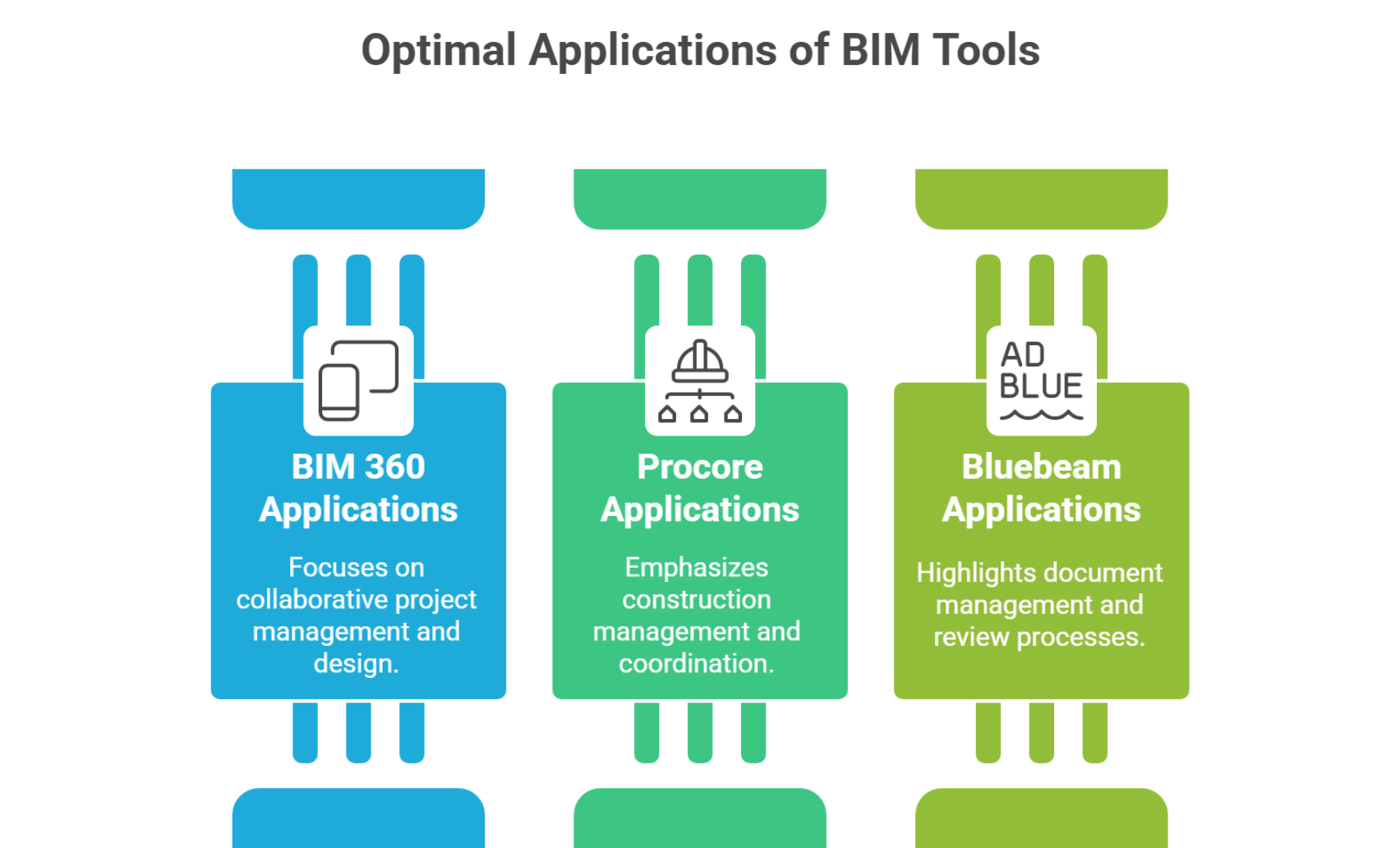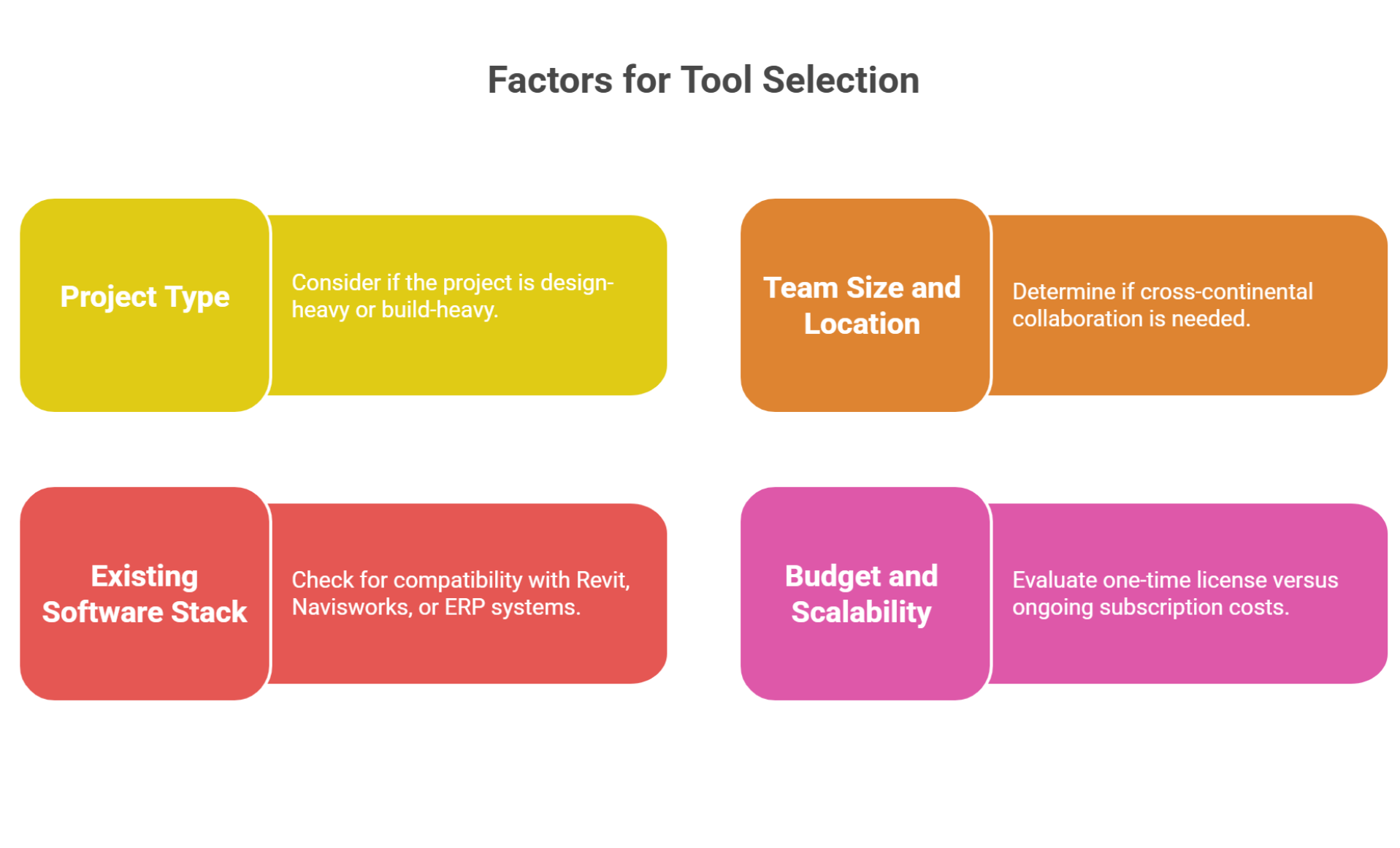
Remote AEC work is normal now. The hard part is picking software that keeps drawings current, models synced, and field notes flowing. BIM 360 vs Procore vs Bluebeam dominate the conversation, but they serve different needs.
BIM 360 (now part of Autodesk Construction Cloud) excels in model-centric workflows. Procore provides comprehensive project management solutions for contractors and owners. Bluebeam specializes in PDF-based markups and document review.
This guide compares BIM 360 vs Procore vs Bluebeam, their strengths, weaknesses, integrations, and suitability for remote and hybrid AEC teams, helping you choose the right fit based on project type, team size, and budget.
Autodesk BIM 360, now part of Autodesk Construction Cloud (ACC), is purpose-built for model-first workflows in architecture, engineering, and construction. It’s not just a document repository; it’s a cloud-hosted Common Data Environment (CDE) with ISO 19650 compliance. This makes it a strong fit for multi-disciplinary, design-driven projects.
BIM 360 excels where model coordination is central, enabling Revit Cloud Worksharing, real-time clash detection, and tight integration with tools like Navisworks and AutoCAD. For global teams dealing with large, complex BIM files, its version control, permissions management, and issue tracking keep everyone aligned.
Best Suited For: Project managers, contractors, Design-heavy, multi-disciplinary teams managing complex BIM models across locations.
Proof point: ACC Model Coordination provides clash detection and issue creation directly in the browser. Gamuda’s roll-out reported 88–91% gains on specific processes.
Notable Strengths:
Procore is a full-spectrum construction management platform designed to manage the entire project lifecycle from preconstruction to closeout. Its strength lies in connecting field teams, office staff, and stakeholders through a central dashboard that covers RFIs, submittals, punch lists, schedules, budgets, and safety documentation.
While it’s not BIM-first like BIM 360, Procore thrives in build-heavy environments where cost control, scheduling, and field productivity are top priorities.
Its Procore Marketplace offers over 400 integrations, including ERP systems, scheduling tools, and safety compliance apps, making it adaptable to diverse project types. Procore is considered the best construction collaboration software.
Best Suited For: General contractors, owners, and construction managers overseeing multiple concurrent projects.
Proof point: Procore’s ROI pages cite survey results such as 15 days saved per project on average and 8 days faster change-order approvals (self-reported). Review case libraries for industry-specific results. (Procore)
Notable Strengths:
Bluebeam is a PDF-based collaboration and markup tool built for fast, visual communication in construction workflows. It’s widely used for document review, real-time annotations, and drawing set management, making it a favorite for RFIs, submittals, and design review sessions.
Its core platform, Bluebeam Revu, allows detailed PDF markups, while Bluebeam Studio enables live collaboration sessions where multiple team members can annotate simultaneously.
While it’s not a full project management suite, it integrates well with platforms like SharePoint and Dropbox, and its ease of use makes it accessible to non-technical stakeholders.
Best Suited For: Subcontractors, consultants, and project managers who need fast, visual collaboration without the complexity of a full PM platform.
Notable Strengths:

Side-by-Side Feature Comparison Table
| Category | BIM 360 / ACC | Procore | Bluebeam |
| Collaboration & Communication | ✓ | Strong | ✓ |
| Document Management | ✓ | Strong | ✓ (PDF only) |
| BIM Integration | Strong (Revit, Navisworks) | Partial (via API) | X |
| Field Management | Partial | ✓ | Partial |
| Cost Tracking & Budgeting | ✓ | ✓ | X |
| Mobile App Capabilities | ✓ | ✓ | Partial |
| Integration with Other Tools | ✓ | ✓ (Marketplace) | Partial |
| Scalability for Teams | ✓ | ✓ | ✓ |
(✓ = Strong, Partial = Limited, X = Not Available)
BIM 360’s power comes with complexity. The platform’s breadth of tools, from model coordination to document control, means a steeper learning curve, especially for teams new to BIM-first workflows. However, for those already using Revit or Navisworks, the interface feels consistent, and Autodesk’s training resources cover most use cases.
Procore is built with usability in mind. Its interface is clean, modern, and intuitive, making onboarding faster for field and office users alike. Role-based dashboards keep information relevant to each team member, reducing confusion.
Bluebeam:
Bluebeam is the easiest to adopt. Most users only need basic training to start marking up PDFs, creating punch lists, or collaborating in Bluebeam Studio. The focus is on quick productivity rather than mastering a large suite of tools.

Deeply integrated with Autodesk products like Revit, AutoCAD, and Navisworks, BIM 360 eliminates many data silos. Through Autodesk Construction Cloud, it also connects with scheduling tools, ERP systems, and analytics platforms. These integrations streamline workflows by ensuring one source of truth for all model-related data.
Procore stands out for its Procore Marketplace, which includes over 400 third-party integrations. This covers everything from accounting and ERP systems to safety management tools. Procore’s open API allows custom integrations, making it ideal for firms with diverse tech stacks.
Bluebeam is more focused on document workflow integrations, connecting with Dropbox, SharePoint, Google Drive, and certain project management tools. Bluebeam Cloud also supports third-party connections for importing drawings (Bluebeam Support). While it doesn’t match the scale of Procore’s marketplace, its tight focus on document handling ensures smooth file sharing and markup processes.
Autodesk uses named-user subscriptions. Users can work offline up to 30 days before the license re-checks (Autodesk Licensing FAQ). Public resellers list annual pricing for BIM Collaborate Pro; exact rates vary by region and pack size (Autodesk; Novedge/Motion Media listings). (Autodesk, 2025). Larger BIM teams can expect higher licensing costs, but the depth of functionality often justifies the investment.
Subscription-based with annual contracts; Procore states unlimited users and “predictable pricing,” with cost tied to company/project scale (Procore Pricing). Industry reviews note pricing is based on Annual Construction Volume (ACV) rather than per-seat. The all-in-one approach means you’re paying for a broad toolset, which can be cost-effective for large, complex projects.
Bluebeam moved to subscriptions (Basics/Core/Complete) covering Revu for Windows plus web and mobile; current U.S. pricing is listed on the webstore. Budget note. Smaller firms often start with Bluebeam for markups and pair it with ACC or Procore later as the scope widens.
Tip: Keep RFIs in Procore (system of record) and attach Session-marked PDFs for clarity.

Remote AE helps AEC teams choose, implement, and run the right collaboration platforms, without overloading internal staff.
Remote AE can help you set up, run, and optimize your collaboration tools while providing trained remote architects and engineers to manage daily operations.
Book your consultation today and discover how the right people and platform setup can transform your AEC workflows. Contact Remote AE, let’s make your remote collaboration work.
Yes. Autodesk is consolidating BIM 360 features into Autodesk Construction Cloud (ACC). Existing BIM 360 projects still work, but new features are being developed for ACC.
No. Bluebeam is a PDF markup and collaboration tool, while Procore is a full project management platform. Bluebeam handles drawing reviews well, but doesn’t manage schedules, budgets, or contracts.
User reviews often favor Procore or ACC for RFIs/submittals due to built-in tracking and audit trails. Bluebeam can support RFIs via markups, but lacks structured workflows.
A common setup is using ACC as the CDE for model hosting and issue tracking, while Bluebeam is used for PDF markups. Marked PDFs are uploaded back into ACC for distribution.
In recent user surveys, Bluebeam scored higher for markup speed and simplicity, while ACC scored higher for centralized project management and multi-team coordination.
Yes, if your team works with both BIM models and PDF sets. The CDE stores and coordinates models, while Bluebeam speeds up PDF reviews. This combo is common in mixed 2D/3D workflows.